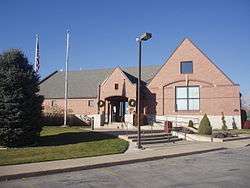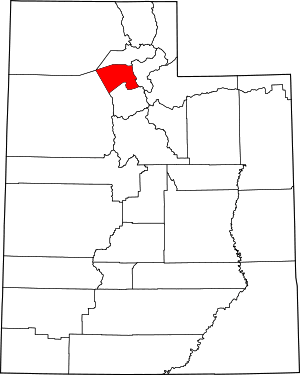Fruit Heights, Utah
Fruit Heights is a city in eastern Davis County, Utah, United States. It is part of the Ogden–Clearfield, Utah Metropolitan Statistical Area. It lies along the Wasatch Front, and is one of the suburbs of Farmington and Kaysville. Its population was 4,987 at the 2010 census,[5] with an estimated population of 6,234 in 2018.[6]
Fruit Heights, Utah | |
|---|---|
 Fruit Heights City Hall | |
 Location in Davis County and the state of Utah | |
| Coordinates: 41°1′41″N 111°54′38″W | |
| Country | United States |
| State | Utah |
| County | Davis |
| Incorporated | 1939 |
| Government | |
| • Mayor or Chief Executive Officer | John M. Pohlman |
| Area | |
| • Total | 2.30 sq mi (5.95 km2) |
| • Land | 2.29 sq mi (5.93 km2) |
| • Water | 0.01 sq mi (0.02 km2) |
| Elevation | 4,698 ft (1,432 m) |
| Population (2010) | |
| • Total | 4,987 |
| • Estimate (2019)[2] | 6,221 |
| • Density | 2,718.97/sq mi (1,049.94/km2) |
| Time zone | UTC-7 (Mountain (MST)) |
| • Summer (DST) | UTC-6 (MDT) |
| ZIP code | 84037 |
| Area code(s) | 385, 801 |
| FIPS code | 49-27490[3] |
| GNIS feature ID | 1441248[4] |
| Website | www |
Geography
Fruit Heights is bordered by the city of Kaysville to the north and west, the city of Farmington to the south, and the Wasatch Range to the east. According to the United States Census Bureau, Fruit Heights has a total area of 2.3 square miles (5.9 km2), of which 0.01 square miles (0.02 km2), or 0.42%, is water.[5]
Demographics
| Historical population | |||
|---|---|---|---|
| Census | Pop. | %± | |
| 1950 | 124 | — | |
| 1960 | 175 | 41.1% | |
| 1970 | 800 | 357.1% | |
| 1980 | 2,728 | 241.0% | |
| 1990 | 3,900 | 43.0% | |
| 2000 | 4,701 | 20.5% | |
| 2010 | 4,987 | 6.1% | |
| Est. 2019 | 6,221 | [2] | 24.7% |
| U.S. Decennial Census[7] | |||
As of 2010, the total population of Fruit Heights was 4,987, which is 6.08% more than it was in 2000. There are 1,466 households, and 1,285 families residing in the city. The population density was 2,184.73 people per square mile (825.0/km2). The racial makeup of the city was 95.79% White, 0.52% African American, 0.48% Native American, 1.22% Asian, 0.84% from other races, and 1.14% from two or more races. Hispanic or Latino of any race were 3.11% of the population.
There were 1,256 households, out of which 48.5% had children under the age of 18 living with them, 81.5% were married couples living together, 5.7% had a female householder with no husband present, and 10.8% were non-families. 9.6% of all households were made up of individuals, and 5.7% had someone living alone who was 65 years of age or older. The average household size was 3.74 and the average family size was 4.02.
In the city, the population was spread out, with 35.1% under the age of 18, 12.3% from 18 to 24, 20.2% from 25 to 44, 24.2% from 45 to 64, and 8.2% who were 65 years of age or older. The median age was 29 years. For every 100 females, there were 99.4 males. For every 100 females age 18 and over, there were 98.7 males.
The median income for a household in the city was $79,192, and the median income for a family was $82,459. Males had a median income of $62,930 versus $26,042 for females. The per capita income for the city was $24,188. About 0.5% of families and 0.7% of the population were below the poverty line, including 1.1% of those under age 18 and none of those age 65 or over.
See also
- List of cities and towns in Utah
References
- "2019 U.S. Gazetteer Files". United States Census Bureau. Retrieved August 7, 2020.
- "Population and Housing Unit Estimates". United States Census Bureau. May 24, 2020. Retrieved May 27, 2020.
- "U.S. Census website". United States Census Bureau. Retrieved 2008-01-31.
- "US Board on Geographic Names". United States Geological Survey. 2007-10-25. Retrieved 2008-01-31.
- "Geographic Identifiers: 2010 Demographic Profile Data (G001): Fruit Heights city, Utah". American Factfinder. U.S. Census Bureau. Archived from the original on February 13, 2020. Retrieved January 11, 2016.
- "Population and Housing Unit Estimates". Retrieved September 24, 2019.
- "Census of Population and Housing". Census.gov. Retrieved June 4, 2015.
